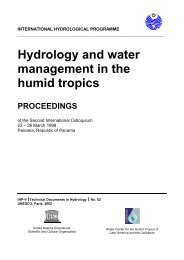FR AB - Science Reference
FR AB - Science Reference
FR AB - Science Reference
Create successful ePaper yourself
Turn your PDF publications into a flip-book with our unique Google optimized e-Paper software.
0.8 pmol/�L with 5 �L per primer tube; again, only<br />
1 �L is added per reaction.<br />
To use the robot to assemble the components of<br />
these reactions, a simple program was composed to<br />
transfer samples between the robot benchtop platform<br />
and the 96-well plate on the connected MJ cycler. A<br />
script is available from Beckman, as well as from MJ<br />
Research, that allows the cycler to close the heated lid<br />
and start cycling on reaction setup completion.<br />
We have found that reactions containing one half<br />
of the manufacturer’s prescribed quantity of Amplitaq<br />
DNA Polymerase FS premix (<strong>AB</strong> PRISM Dye Terminator<br />
Cycle Sequencing Ready Reaction Kit using 4 �L<br />
premix per reaction with the <strong>AB</strong> recommended<br />
amount of DNA template and primer), yielding a total<br />
volume of 10 �L, works better and is more costefficient<br />
than the standard <strong>AB</strong> protocol that includes<br />
8 �L premix in each reaction, yielding a total volume<br />
of 20 �L. 1<br />
� PHAGE/COSMID/BAC<br />
SEQUENCING METHODS<br />
Protocols have been designed and optimized for<br />
sequencing reactions other than standard doublestranded<br />
or single-stranded DNA templates. These<br />
sequences are done manually and cycled on an MWG<br />
cycler (Biotech, High Point, NC), but can be done on<br />
the robot with the appropriate programming.<br />
With Amplitaq FS terminator chemistry, BAC sequencing<br />
requires a large-scale reaction for maximum<br />
output of at least 500 bases per reaction and minimum<br />
background. Sixteen microliters of premix is combined<br />
with 1 �g of DNA template and 50 pmol primer<br />
and dH2O to give a total volume of 40 �L. 2<br />
Cosmid and � phage reactions are performed<br />
using 500 ng DNA (the standard amount of DNA used<br />
in double-stranded and single-stranded reactions), but<br />
with 12.8 pmol of primer (approximately 4 times the<br />
standard 3.2 pmol amount) and 8 �L premix to provide<br />
a total reaction volume of 20 �L.<br />
For reaction product purification, Centrisep spin<br />
columns (Princeton Separations, Adelphia, NJ) are<br />
used on an individual basis for the reactions performed<br />
manually, as described in the product manual.<br />
A 96-well system (Edge Biosystems, Gaithersburg,<br />
MD) is used for product purification of the robotprepared<br />
automated sequencing reactions performed<br />
in the 96-well cycler. Product purification is also done<br />
with the assistance of the robot. A simple program<br />
was written to transfer the cycled sequencing reactions<br />
directly onto the center of each well of a 96-well<br />
separation plate with gel bed of hydrated sephadex<br />
mixture. After all reaction mixtures are transferred to<br />
AUTOMATION IN SMALL-SCALE DNA SEQUENCING FACILITY<br />
this separation plate, the plate is centrifuged at 800<br />
rpm in a Beckman GS-15 microtiter tray centrifuge<br />
with a collection tray underneath it to collect the purified<br />
sequencing sample. This tray is then placed in a<br />
Jouan R6-1010 vacuum centrifuge (Jouan, Winchester,<br />
VA) to dry the samples. The dried samples, as well as<br />
those dried samples prepared via Centrisep columns,<br />
are then resuspended in 2-�L Accutrac dye (3 �L for<br />
the <strong>AB</strong> 373 sequencer; Commonwealth BioTechnologies,<br />
Richmond, VA), which provides a unique dye<br />
marker for each lane on the gel image regardless of<br />
whether or not the reaction has failed. This reduces<br />
software errors in lane tracking. After the samples are<br />
resuspended in dye, they are vortexed and centrifuged<br />
at maximum speed for 30 seconds and then<br />
heat denatured at 90�C for 2 minutes. The samples are<br />
then loaded onto the sequencers in a staggered manner<br />
in which the odd samples are loaded first and<br />
subjected to electrophoreses for 10 minutes, and then<br />
the even samples are loaded.<br />
GELS<br />
Biowhitaker prepackaged Singel gels (Long Ranger<br />
Singel packs for <strong>AB</strong> 373 and 377; BMA, Rockland, ME)<br />
are used as a simple, efficient alternative to making<br />
our own gel solutions. It takes 12 minutes to prepare<br />
the gels for pouring. Using mild alkanox detergent<br />
and isopropanol to clean the glass plates, the gel solution<br />
is placed in a side-arm flask for pouring onto the<br />
plates using an Owl Scientific Otter sequencing gel<br />
caster (Owl Separation Systems, Portsmouth, NH).<br />
A period of 2 to 2.5 hours is necessary to allow the<br />
gels to completely polymerize; other steps in the<br />
process are performed during this period.<br />
DATA ANALYSIS<br />
The core facility currently processes 1000 to 1500<br />
sequence reactions per month, with about 60 facility<br />
users submitting templates for sequencing. Data from<br />
each sequence run is immediately backed up on a<br />
gigabyte tape drive and copied onto a CD for permanent<br />
storage. In addition, a summary of the sequencing<br />
results is transferred to tape for short-term storage.<br />
Gel image files are kept for 3 days to enable retracking<br />
or for use of alternative base-calling programs, if<br />
necessary.<br />
When novice users first submit templates for<br />
sequencing, they are given a written set of instructions<br />
concerning template preparation and quantitation.<br />
They are also instructed in how to configure their<br />
Netscape Navigator (Netscape Communications Corp.,<br />
Mountain View, CA) to download sequences from the<br />
JOURNAL OF BIOMOLECULAR TECHNIQUES, VOLUME 11, ISSUE 4, DECEMBER 2000 153















